Hyundai Getz 2009 Owner's Manual - RHD (UK, Australia)
Manufacturer: HYUNDAI, Model Year: 2009, Model line: Getz, Model: Hyundai Getz 2009Pages: 191, PDF Size: 6.3 MB
Page 121 of 191
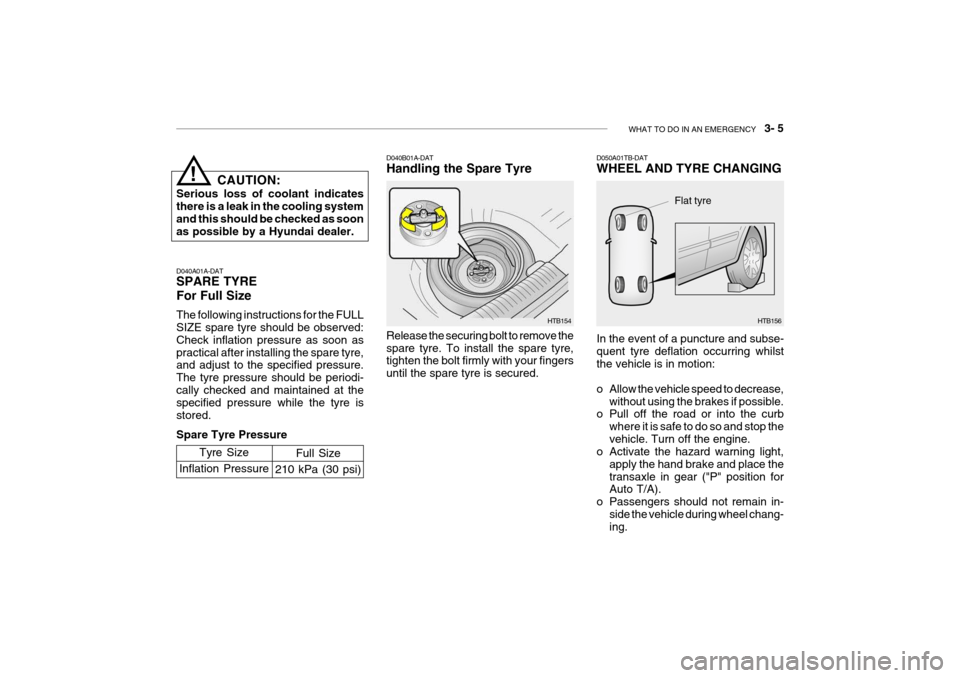
WHAT TO DO IN AN EMERGENCY 3- 5
!
CAUTION:
Serious loss of coolant indicates there is a leak in the cooling system and this should be checked as soon as possible by a Hyundai dealer.
Tyre Size
Inflation Pressure
D040A01A-DAT SPARE TYRE For Full Size The following instructions for the FULL SIZE spare tyre should be observed: Check inflation pressure as soon as practical after installing the spare tyre, and adjust to the specified pressure. The tyre pressure should be periodi-cally checked and maintained at the specified pressure while the tyre is stored. Spare Tyre Pressure D040B01A-DAT Handling the Spare Tyre Release the securing bolt to remove the spare tyre. To install the spare tyre, tighten the bolt firmly with your fingers until the spare tyre is secured.
HTB154
Full Size
210 kPa (30 psi) D050A01TB-DAT WHEEL AND TYRE CHANGING In the event of a puncture and subse- quent tyre deflation occurring whilstthe vehicle is in motion:
o Allow the vehicle speed to decrease,
without using the brakes if possible.
o Pull off the road or into the curb
where it is safe to do so and stop the vehicle. Turn off the engine.
o Activate the hazard warning light,
apply the hand brake and place thetransaxle in gear ("P" position for Auto T/A).
o Passengers should not remain in-
side the vehicle during wheel chang-ing.
HTB156
Flat tyre
Page 122 of 191
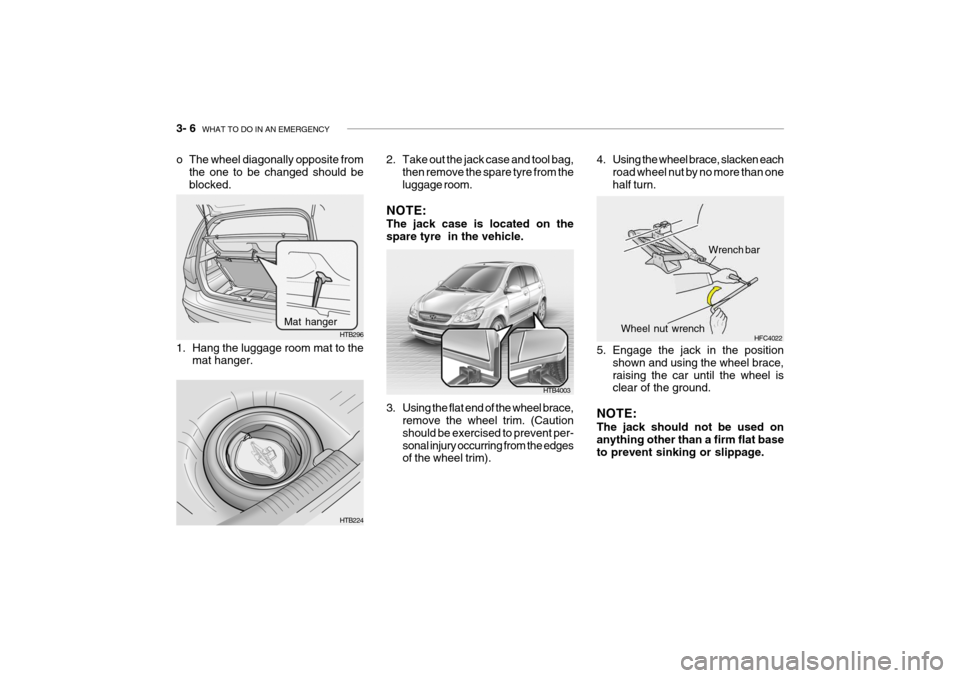
3- 6 WHAT TO DO IN AN EMERGENCY
o The wheel diagonally opposite from
the one to be changed should be blocked.
HTB224
HTB296
Mat hanger
1. Hang the luggage room mat to the mat hanger. 2. Take out the jack case and tool bag,
then remove the spare tyre from the luggage room.
NOTE: The jack case is located on the spare tyre in the vehicle.
3. Using the flat end of the wheel brace, remove the wheel trim. (Caution should be exercised to prevent per-sonal injury occurring from the edges of the wheel trim). HTB40034. Using the wheel brace, slacken each
road wheel nut by no more than one half turn.
5. Engage the jack in the position shown and using the wheel brace,raising the car until the wheel is clear of the ground.
NOTE: The jack should not be used on anything other than a firm flat base to prevent sinking or slippage.
HFC4022
Wrench bar
Wheel nut wrench
Page 123 of 191
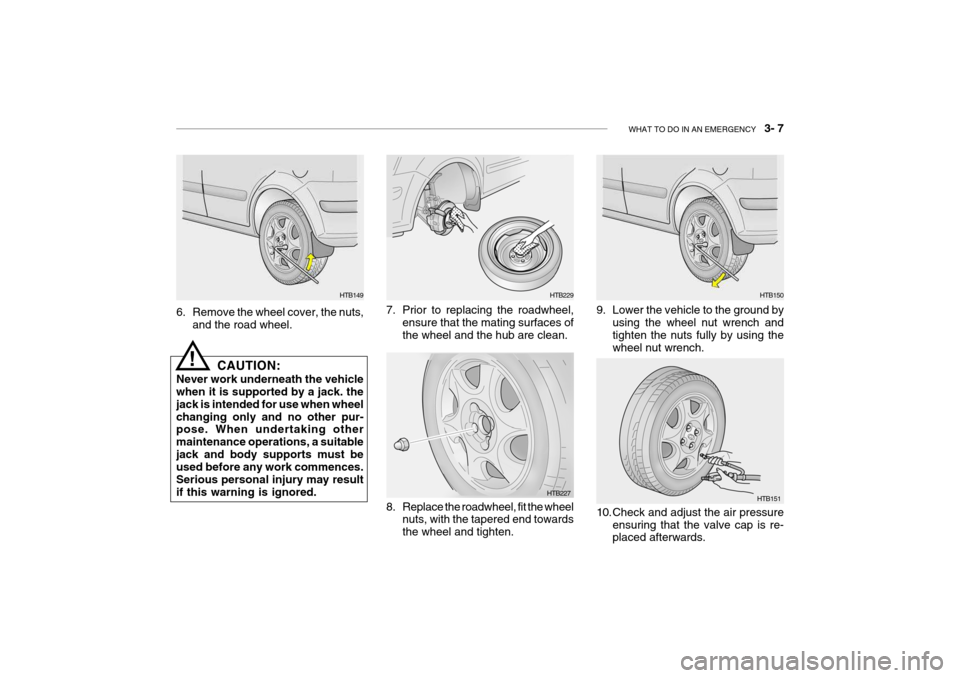
WHAT TO DO IN AN EMERGENCY 3- 7
6. Remove the wheel cover, the nuts,
and the road wheel.
HTB149
CAUTION:
Never work underneath the vehicle when it is supported by a jack. the jack is intended for use when wheelchanging only and no other pur- pose. When undertaking other maintenance operations, a suitablejack and body supports must be used before any work commences. Serious personal injury may resultif this warning is ignored. 7. Prior to replacing the roadwheel,
ensure that the mating surfaces ofthe wheel and the hub are clean.
!
HTB229
8. Replace the roadwheel, fit the wheel nuts, with the tapered end towards the wheel and tighten.
HTB227 9. Lower the vehicle to the ground by
using the wheel nut wrench and tighten the nuts fully by using the wheel nut wrench.
HTB150
10. Check and adjust the air pressure ensuring that the valve cap is re- placed afterwards. HTB151
Page 124 of 191
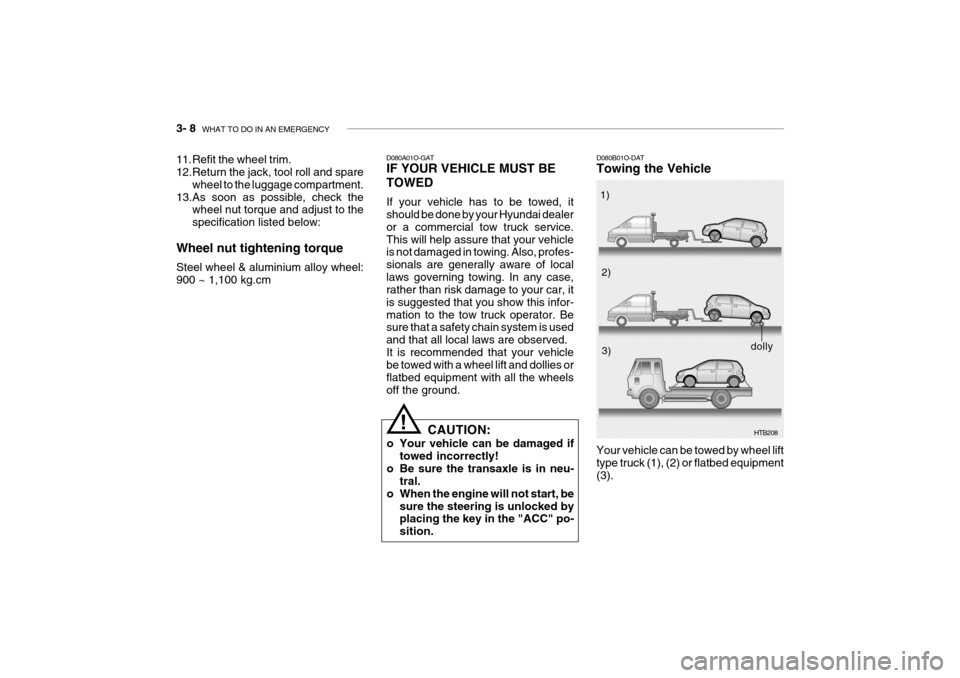
3- 8 WHAT TO DO IN AN EMERGENCY
11. Refit the wheel trim.
12.Return the jack, tool roll and spare
wheel to the luggage compartment.
13.As soon as possible, check the wheel nut torque and adjust to the specification listed below:
Wheel nut tightening torque Steel wheel & aluminium alloy wheel: 900 ~ 1,100 kg.cm D080A01O-GAT IF YOUR VEHICLE MUST BE TOWED If your vehicle has to be towed, it should be done by your Hyundai dealer or a commercial tow truck service.This will help assure that your vehicle is not damaged in towing. Also, profes- sionals are generally aware of locallaws governing towing. In any case, rather than risk damage to your car, it is suggested that you show this infor-mation to the tow truck operator. Be sure that a safety chain system is used and that all local laws are observed.It is recommended that your vehicle be towed with a wheel lift and dollies or flatbed equipment with all the wheelsoff the ground.
!
CAUTION:
o Your vehicle can be damaged if towed incorrectly!
o Be sure the transaxle is in neu- tral.
o When the engine will not start, be sure the steering is unlocked by placing the key in the "ACC" po- sition. D080B01O-DAT Towing the Vehicle
HTB208
Your vehicle can be towed by wheel lift type truck (1), (2) or flatbed equipment(3). 1)
2)
3)
dolly
Page 125 of 191
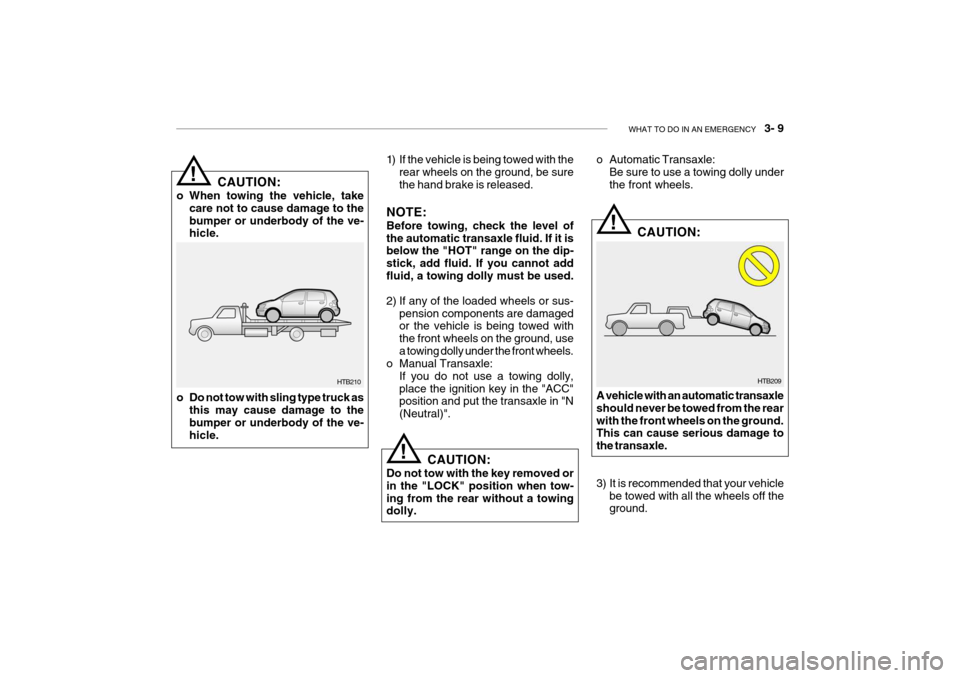
WHAT TO DO IN AN EMERGENCY 3- 9
HTB209
!
!
1) If the vehicle is being towed with the
rear wheels on the ground, be sure the hand brake is released.
NOTE: Before towing, check the level of the automatic transaxle fluid. If it is below the "HOT" range on the dip- stick, add fluid. If you cannot addfluid, a towing dolly must be used.
2) If any of the loaded wheels or sus- pension components are damaged or the vehicle is being towed with the front wheels on the ground, usea towing dolly under the front wheels.
o Manual Transaxle:
If you do not use a towing dolly,place the ignition key in the "ACC" position and put the transaxle in "N (Neutral)".
CAUTION:
Do not tow with the key removed orin the "LOCK" position when tow-ing from the rear without a towing dolly. o Automatic Transaxle:
Be sure to use a towing dolly under the front wheels.
CAUTION:
A vehicle with an automatic transaxleshould never be towed from the rearwith the front wheels on the ground. This can cause serious damage to the transaxle.
3) It is recommended that your vehicle be towed with all the wheels off the ground.
! CAUTION:
o When towing the vehicle, take care not to cause damage to the bumper or underbody of the ve- hicle.
o Do not tow with sling type truck as this may cause damage to thebumper or underbody of the ve- hicle. HTB210
Page 126 of 191
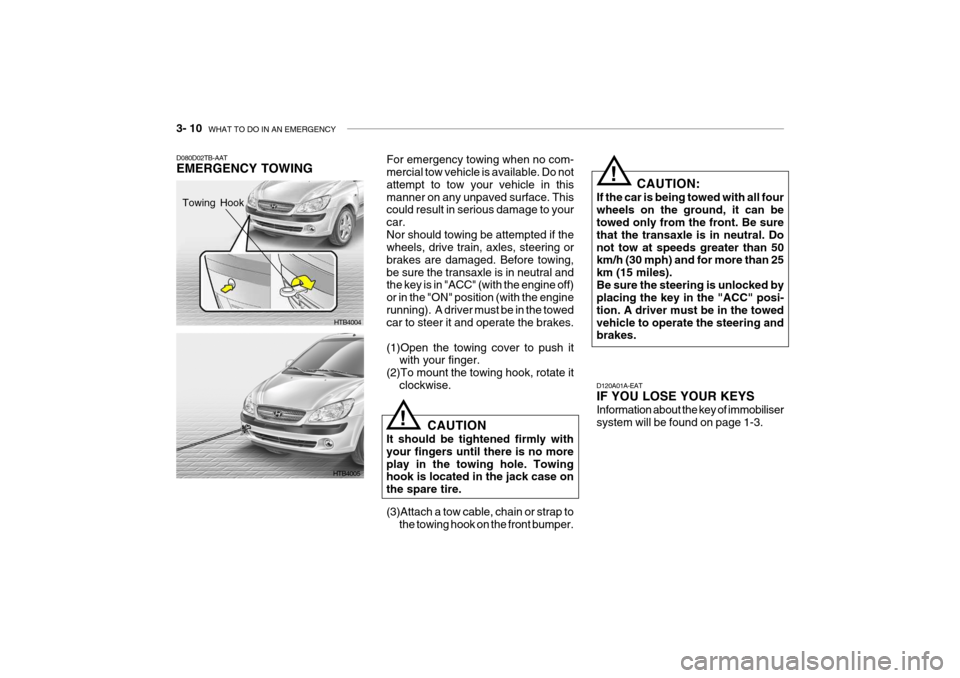
3- 10 WHAT TO DO IN AN EMERGENCY
D080D02TB-AAT EMERGENCY TOWING For emergency towing when no com- mercial tow vehicle is available. Do not attempt to tow your vehicle in thismanner on any unpaved surface. This could result in serious damage to your car.Nor should towing be attempted if the wheels, drive train, axles, steering or brakes are damaged. Before towing,be sure the transaxle is in neutral and the key is in "ACC" (with the engine off) or in the "ON" position (with the enginerunning). A driver must be in the towed car to steer it and operate the brakes. (1)Open the towing cover to push it
with your finger.
(2)To mount the towing hook, rotate it clockwise.
HTB4004
D120A01A-EAT IF YOU LOSE YOUR KEYS Information about the key of immobiliser system will be found on page 1-3.
HTB4005 CAUTION:
If the car is being towed with all fourwheels on the ground, it can be towed only from the front. Be sure that the transaxle is in neutral. Donot tow at speeds greater than 50 km/h (30 mph) and for more than 25 km (15 miles).Be sure the steering is unlocked by placing the key in the "ACC" posi- tion. A driver must be in the towedvehicle to operate the steering and brakes.
!
CAUTION
It should be tightened firmly with your fingers until there is no moreplay in the towing hole. Towing hook is located in the jack case on the spare tire. (3)Attach a tow cable, chain or strap to the towing hook on the front bumper.
!
Towing Hook
Page 127 of 191

4. CORROSION PREVENTION &APPEARANCE CARE
Corrosion protection ....................................................................... 4-2
To help prevent corrosion ............................................................... 4-2
Washing and waxing ...................................................................... 4-3
Cleaning the interior ......................................................................... 4-6
4
Page 128 of 191

4- 2 CORROSION PREVENTION AND APPEARANCE CARE
E010A01A-AAT CORROSION PROTECTION Protecting Your Hyundai fromCorrosion: By using the most advanced design and construction practices to combat corrosion, Hyundai produces cars ofthe highest quality. However, this is only part of the job. To achieve long- term corrosion resistance your Hyun-dai can deliver, the owner's coopera- tion and assistance is also required. E010C01A-AAT High-Corrosion Areas If you live in an area where your car is regularly exposed to corrosive materi-als, corrosion protection is particularly important. Some of the common causes of accelerated corrosion areroad salts, dust control chemicals, ocean air and industrial pollution.
E010B01A-AAT Common Causes of Corrosion The most common causes of corro- sion on your car are:
o Road salt, dirt and moisture that is allowed to accumulate underneath the car.
o Removal of paint or protective coat- ings by stones, gravel, abrasion orminor scrapes and dents which leaveunprotected metal exposed to cor- rosion. E010D01A-AAT Moisture Breeds Corrosion Moisture creates the conditions in which corrosion is most likely to occur. For example, corrosion is accelerated by high humidity, particularly when tem-peratures are just above freezing. In such conditions, the corrosive mate- rial is kept in contact with the carsurfaces by moisture that is slow to evaporate. Mud is particularly corrosive becauseit is slow to dry and holds moisture in contact with the vehicle. Although themud appears to be dry, it can still retain the moisture and promote corrosion. High temperatures can also acceler-ate corrosion of parts that are not properly ventilated so the moisture can be dispersed. For all these rea-sons, it is particularly important to keep your car clean and free of mud or accumulations of other materials. Thisapplies not only to the visible surfaces but particularly to the underside of the car. E020A01A-AAT TO HELP PREVENT CORRO- SION You can help prevent corrosion from starting by observing the following:
Page 129 of 191

CORROSION PREVENTION AND APPEARANCE CARE 4- 3
E020C01A-AAT Keep Your Garage Dry Don't park your car in a damp, poorly ventilated garage. This creates a fa- vorable environment for corrosion. This is particularly true if you wash your carin the garage or drive it into the garage when it is still wet or covered with snow, ice or mud. Even a heated ga-rage can contribute to corrosion un- less it is well ventilated so moisture is dispersed. E020D01A-AAT Keep Paint and Trim in Good Condition Scratches or chips in the finish should be covered with "touch-up" paint as soon as possible to reduce the possi-bility of corrosion. If bare metal is show- ing through, the attention of a qualified body and paint shop is recommended. E020E01A-AAT Don't Neglect the Interior Moisture can collect under the floor mats and carpeting causing corrosion.Check under the mats periodically to be sure the carpeting is dry. Use particular care if you carry fertilisers, cleaningmaterials or chemicals in the car. These should be carried only in proper containers and any spills or leaks shouldbe cleaned up immediately, flushed with clear water and thoroughly dried.
E020B01A-AAT Keep Your Car Clean The best way to prevent corrosion is to keep your car clean and free of corro-sive materials. Attention to the under- side of the car is particularly important.
o If you live in a high-corrosion area —
where road salts are used, near the ocean, areas with industrial pollu-tion, acid rain, etc.—, you should take extra care to prevent corro- sion. In winter, hose off the under-side of your car at least once a month and be sure to clean the underside thoroughly when winteris over.
o When cleaning underneath the car,
give particular attention to the com-ponents under the fenders and other areas that are hidden from view. Do a thorough job; just dampening theaccumulated mud rather than wash- ing it away will accelerate corrosion rather than prevent it. Water underhigh pressure and steam are par- ticularly effective in removing accu- mulated mud and corrosive materi-als. o When cleaning lower door panels,
rocker panels and frame members,be sure that drain holes are keptopen so that moisture can escape and not be trapped inside to ac- celerate corrosion.
E030A03A-DAT WASHING AND WAXING Washing Your Hyundai Never wash your car when the surface is hot from being in the sun. Always wash your car in the shade. Wash your car frequently. Dirt is abra- sive and can scratch the paint if it is notremoved. Air pollution or acid rain may damage the paint and trim through chemical action if pollutants are al-lowed to remain in contact with the surface. If you live near the ocean or in an area where road salts or dust con-
Page 130 of 191

4- 4 CORROSION PREVENTION AND APPEARANCE CARE
trol chemicals are used, you should pay particular attention to the underside of the car. Start by rinsing the car toremove dust and loose dirt. In winter, or if you have driven through mud or muddy water, be sure to thoroughly clean theunderside as well. Use a hard direct stream of water to remove accumu- lated mud or corrosive materials.High pressure car washes may cause water to enter your vehicle. Use a good quality car-washing solution and followthe manufacturer's directions on the package. These are available at your Hyundaidealer or auto parts outlet. Don't use strong household detergents, petrol, strong solvents or abrasive cleaningpowders as these may damage the finish. Use a clean lambs wool mitt or a cloth,rinse it frequently and don't damage the finish by rubbing too hard. For stubborn spots, dampen them frequently andremove them a little at a time. To clean whitewall tyres, use a stiff brush or soap-impregnated steel-woolscouring pad. To clean plastic wheel covers, use a clean sponge or soft cloth and water. To clean cast aluminum alloy wheels, use a mild soap or neutral detergent. Do not use abrasive cleaners. Protectthe bare-metal surfaces by cleaning, polishing and waxing. Because alumi- num is subject to corrosion, be sure togive aluminum alloy wheels special attention in winter. If you drive on salted roads, clean the wheels thor-oughly afterwards. After washing, be sure to rinse thor- oughly. If soapy water dries on the finish, streaking will result. When the weather is warm and the humidity low, you may find it neces- sary to rinse each section immediatelyafter washing to avoid streaking. After rinsing, dry the car using a damp chamois or soft, absorbent cloth. The reason for drying the car is to remove water from the car so it will dry withoutwater spots. Don't rub, this can dam- age the finish. If you find any nicks or scratches in thepaint, use touch-up paint to cover them to prevent corrosion. To protect thepaintwork of the car against corrosion, you must clean your Hyundai (at least once a month). Give special attentionto the removal of salt, mud and other substances on the underside of the splashboards of the car. Make surethat the outlets and the underside of the doors are open. Paint damage can be caused by small accumulation oftar, industrial precipitation, tree resin, insects and bird droppings, when not removed immediately. If water alone isnot strong enough to remove the accu- mulated dirt, use a mild car washing solution. Be sure to rinse the surfaceafter washing to remove the solution. Never allow the solution to dry on the painted surfaces.